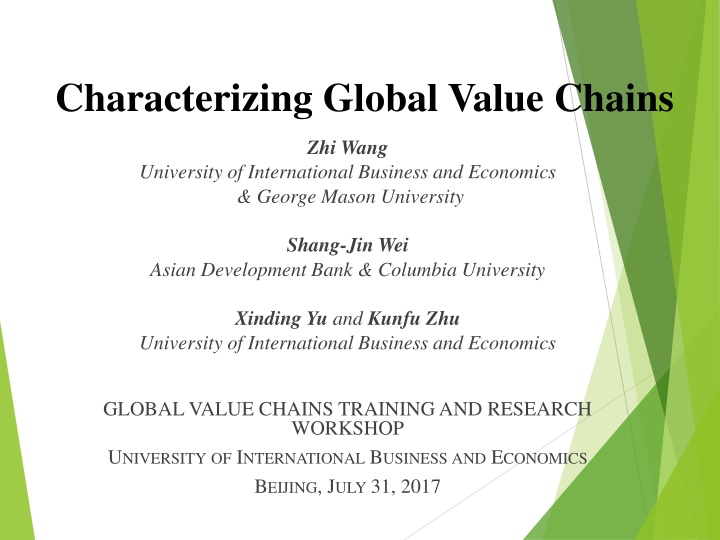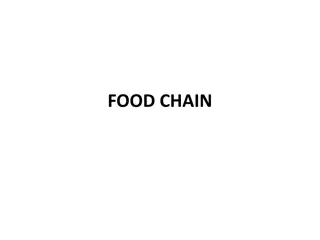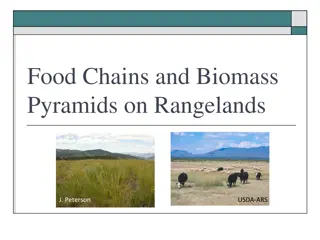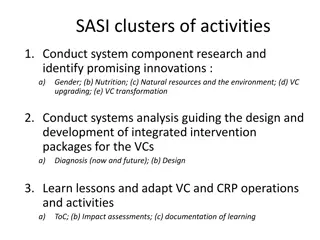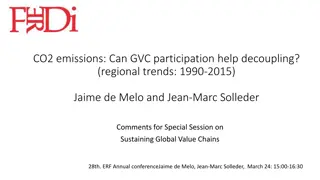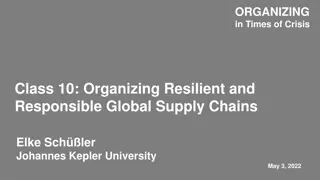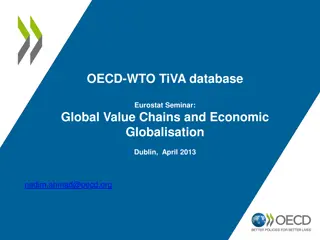Characterizing Global Value Chains
This comprehensive research workshop delves into characterizing global value chains, decomposing production activities, measuring production length, and identifying GVC activities across borders. Explore the concepts behind global value chains and the analytical tools used to study them.
Download Presentation

Please find below an Image/Link to download the presentation.
The content on the website is provided AS IS for your information and personal use only. It may not be sold, licensed, or shared on other websites without obtaining consent from the author.If you encounter any issues during the download, it is possible that the publisher has removed the file from their server.
You are allowed to download the files provided on this website for personal or commercial use, subject to the condition that they are used lawfully. All files are the property of their respective owners.
The content on the website is provided AS IS for your information and personal use only. It may not be sold, licensed, or shared on other websites without obtaining consent from the author.
E N D
Presentation Transcript
Characterizing Global Value Chains Zhi Wang University of International Business and Economics & George Mason University Shang-Jin Wei Asian Development Bank & Columbia University Xinding Yu and Kunfu Zhu University of International Business and Economics GLOBAL VALUE CHAINS TRAINING AND RESEARCH WORKSHOP UNIVERSITY OF INTERNATIONAL BUSINESS AND ECONOMICS BEIJING, JULY 31, 2017
Road Map Identifying GVC activities through decompose production activities Intuition behind the decomposition and simplified math derivation Application example: China and US The concept of average production length Intuition behind the derivation of production length indexes Major segments of production length The Production length index system Measuring production length based on the decomposition of production activities - Numerical results Select examples based on WIOD 2016 data Has GVC become longer or shorter over time Change of production length in the slow recover period after 2012 Relation to other length measure in the literature Shortcomings of the up- and downstreamness indexes used in the literature The difference between APL measure and Production length index defined in this paper
Decompose Production Activities and Measure GVCs Identify Production of Value-added Forward or Final products(backward GVC Production sharing between two or more countries GVCs Pure Domestic No border crossing Traditional Trade Cross border for consumption Cross border for production Portugal Wine in Exchange England Cloth Intermediate trade Hair cut Simple GVCs Cross border once for production Chinese Steel in US building Complex GVCs cross border at least twice 3 i-phone Auto
Gross outputs X can be split into intermediate and final products ?? + ? = ? ? = (? ?) 1Y = ?? B is the (Global) Leontief inverse matrix r, j V B = X V Y s, i GN GN Value added from a source country-sector i,s used in the production of final goods and services in country-sector r, j
Local Leontief Inverse Matrices: an analytical tool to isolate pure domestic production ss 11 ss 12 sr 11 sr 12 b b b b 1 a ss ss ss ss 0 0 1 0 0 l l a a 11 ss l 12 ss l 11 12 a ss 21 ss 22 sr 21 sr 22 b b b b ss ss 0 l 0 l 1 0 0 a = B = = 21 0 22 0 21 0 22 L rs 11 rs 12 rr 11 rr 12 b b b b rr rr rr rr 0 1 a 11 rr l 12 rr l 11 rr 12 a rs 21 rs 22 rr 21 rr 22 b b b b rr 0 0 0 0 1 a 21 22 21 22 1 ss ss B L ss ss 1 a a = ss 11 ss 12 a L ss 1 a 21 22 = ss ss ss sr rs 0 B Total output requirement coefficients of Country s by one unit increase of its production of domestically demanded final goods via intermediate goods trade. L L A B ss 11 ss 12 b b = ss B ss 21 ss 22 b b
Decomposition of value added and final goods production by country/industries: Major results X V = = + + D F F V B Y L V Y D L V Y RT V LA B Y ) 1 ( ) 2 ( ) 3 ( GVCs ????? ?= ????? ?? + ????(? ? ? ??) 3a ???_? 3b ???_? s ss ss s ss sr s ss sr rr rr 0 0 0 V L Y V L Y V L A L Y = + + V B Y r rr rr r rr rs r rr rs ss ss 0 0 0 V L Y V L Y V L A L Y Domestic Pure (1) Traditiona (2) V trade l ) 3 ( Y SimpleGVC a ) + + + s ss sr rs ss rr rs s ss sr rr rr rr rs sr ( ) Y [( A V L A B Y B Y L A B L Y B + ) Y + r rr rs ss ss ss sr rs r rr rs sr rr ss sr [( ] ( ) V L A B L B V L B Y B Y Complex (3b) GVCs
Forward linkage-based: Producer perspective Backward linkage-based: User perspective Backward Linkage GVC Participation: ?_??? ? Forward Linkage GVC Participation: ?_??? ? Summing up each GN by GN matrix along the row direction: Decompose value-added generated from each country-sector pair in terms of where it goes. Summing up each GN by GN matrix along the column direction: Decompose country- sector final goods production in terms of where the value added comes from.
Complex GVCs were effected the most during economic shocks Pure domestic production Traditional trade production Simple GVCs Complex GVCs 8 Based on WIOD2016. http://139.129.209.66:8000/d/daedafb854/ Source UIBE GVC Index
Application example Decomposition of China s manufacturing sector Backward Forward Financial Crisis Dotcom Bust 80% 80% Dotcom Bust Financial Crisis Domestic 70% Domestic 60% 60% 50% 40% 30% Traditional Trade Traditional Trade 20% 20% Complex GVC Simple GVC 10% Complex GVC Simple GVC 0 0 2000 1 2 2001 3 2002 4 2003 5 2004 6 2005 7 2006 8 2007 9 2008 10 11 12 13 14 15 2000 2010 2011 2012 2013 2014 2009 1 2 2001 3 2002 4 2003 5 2004 6 2005 7 2006 8 2007 9 2008 10 11 12 13 14 15 2010 2011 2012 2013 2014 2009 Based on WIOD2016. http://139.129.209.66:8000/d/daedafb854/ Source UIBE GVC Index Since 2009, in both forward and backward Linkage based decomposition pure domestic production increase traditional trade production decline production sharing GVC activities also slightly decline deepening, more intermediate inputs produced domestically the share of cross country 9 domestic division of labor
Different type activities as share of US GDP/final goods production, 1995-2014 All sectors Backward Linkage Forward Linkage 94% 94% DotcomBust DotcomBust FinancialCrisis FinancialCrisis 92% 92% Domestic 90% 90% Domestic 88% 88% 2000 2002 2004 2006 2008 2010 2012 2014 2000 2002 2004 2006 2008 2010 2012 2014 10% 10% Forward backward 8% 8% 6% 6% Simple GVC Simple GVC Traditional Trade 4% 4% Traditional Trade 2% 2% Complex GVC Complex GVC 0% 0% 2000 2002 2004 2006 2008 2010 2012 2014 2000 2002 2004 2006 2008 2010 2012 2014 Manufacturing industries DotcomBust DotcomBust 80% 78% 76% FinancialCrisis FinancialCrisis 78% 74% 76% 72% 74% Domestic Domestic 70% 72% 68% 70% 66% 2000 2002 2004 2006 2008 2010 2012 Traditional Trade 2014 2000 2002 2004 2006 2008 2010 2012 2014 Traditional Trade 12% 14% 10% 12% Simple GVC Simple GVC 8% 10% 8% 6% 6% Complex GVC Complex GVC 4% 4% 2% 2% 0% 0% 2000 2002 2004 2006 2008 2010 2012 2014 2000 2002 2004 2006 2008 2010 2012 2014
Different type activities as share of sector GDP/final goods production, 1995-2014 Computer, electronic and optical products DotcomBust 70% DotcomBust 66% FinancialCrisis FinancialCrisis 65% 64% 60% 62% Domestic Domestic 55% 60% 58% 50% 2000 2002 2004 2006 2008 2010 2012 2014 2000 2002 2004 2006 2008 2010 2012 2014 20% 45% 15% Forward backward Traditional Trade 30% Traditional Trade Complex GVC 10% Simple GVC 15% 5% Complex GVC Simple GVC 0% 0% 2000 Electrical equipment 2002 2004 2006 2008 2010 2012 2014 2000 2002 2004 2006 2008 2010 2012 2014 DotcomBust 80% DotcomBust 78% 75% FinancialCrisis 76% FinancialCrisis 70% 74% 72% 65% Domestic 70% 60% Domestic 68% 55% 66% 50% 64% 2000 2002 2004 2006 2008 2010 2012 2014 2000 2002 2004 2006 2008 2010 2012 2014 25% 14% Simple GVC Traditional Trade 12% 20% Traditional Trade 10% 15% Complex GVC 8% Simple GVC 10% 6% Complex GVC 4% 5% 2% 0% 0% 2000 2002 2004 2006 2008 2010 2012 2014 2000 2002 2004 2006 2008 2010 2012 2014
Different type activities as share of US GDP/final goods production, 1995-2014 Motor vehicles Forward Linkage Backward Linkage 80% 84% DotcomBust DotcomBust 82% 75% 80% 70% FinancialCrisis FinancialCrisis 78% 65% 76% Domestic Domestic 60% 74% 55% 72% 70% 50% 2000 2002 2004 2006 2008 2010 2012 2014 2000 2002 2004 2006 2008 2010 2012 2014 20% 14% Traditional Trade Simple GVC 12% Forward backward 15% 10% Traditional Trade Simple GVC 8% 10% 6% Complex GVC Complex GVC 4% 5% 2% 0% 0% 2000 Machinery 2002 2004 2006 2008 2010 2012 2014 2000 2002 2004 2006 2008 2010 2012 2014 80% 80% DotcomBust DotcomBust 75% 75% FinancialCrisis 70% 70% FinancialCrisis 65% 65% Domestic Domestic 60% 60% 55% 55% 50% 50% 2000 2002 2004 2006 2008 2010 2012 2014 2000 2002 2004 2006 2008 2010 2012 2014 25% 30% 25% 20% Traditional Trade Traditional Trade 20% 15% 15% Simple GVC Simple GVC 10% 10% Complex GVC 5% Complex GVC 5% 0% 0% 2000 2002 2004 2006 2008 2010 2012 2014 2000 2002 2004 2006 2008 2010 2012 2014
GVC Participation index for Major Economies, 2011 Computer, electronic and optical machineries Upstream CHN CHN-PRO CHN-NPR China Processing No processing World average: 33.0% Downstream World average 36.1% 14
Intensity of GVC participation by US industries 2000, 2007 and 2014 0.6 0.5 Forward-Linkage 0.0572 Forward-Linkage 0.0682 2007 2000 0.5 0.4 Agriculture 0.4 Mining Agriculture 0.3 Manufacturing Mining Service Manufacturing 0.3 Service 0.2 0.2 0.1 0.0498 0.1 0.0546 Backward-Linkage Backward-Linkage 0.0 0 0.0 0.1 0.2 0.3 0.4 0.5 0 0.1 0.2 0.3 0.4 0.5 0.6 0.7 GVC participation is continue increasing by most US industries, both forward and backward participation rate increased more than1.3 percentage point on average during past 15 years; There is significant cross sector variation in GVC participation, Mining and Agricultural sectors located in the left up corner , services is much lower than manufacture Forward-Linkage 0.0704 2014 0.6 0.5 Agriculture Mining Manufacturing 0.4 Service 0.3 0.2 0.1 0.0631 Backward-Linkage 0 0 0.1 0.2 0.3 0.4 0.5 0.6 0.7
Intensity of GVC participation by US manufacturing industries, 2000, 2007 and 2014 0.45 0.60 0.143 0.178 Forward-Linkage Forward-Linkage 2000 2007 0.40 0.50 0.35 0.30 0.40 0.25 opt 0.30 bmet che 0.20 tra bmet che ele opt pap rub fmp 0.136 0.15 0.20 ele tra pap rub equ pha 0.148 pha equ fmp tex nmet veh tex 0.10 wod veh petr petr nmet 0.10 wod prt prt 0.05 fur fur fod fod Backward-Linkage Backward-Linkage 0.00 0.00 0.00 0.05 0.10 0.15 0.20 0.25 0.30 0.35 0.40 0.45 0.00 0.10 0.20 0.30 0.40 0.50 0.60 US manufacturing industries continue increase their GVC participation intensity, already exceed the peak before the global financial crisis (both vertical and horizontal scale are enlarging overtime) Upstream: computer, electronic and optical products (opt); basic metals (bmet); chemicals (che); pharmaceuticals (pha) ; Downsteam: motor vehicles (veh); machinery(equ); textile (tex); furniture (fur) 0.70 0.205 Forward-Linkage 2014 0.60 0.50 0.40 0.30 bmet che ele tra pap pha rub 0.166 opt 0.20 fmp petr equ nmet wod prt tex veh 0.10 fur fod Backward-Linkage 0.00 0.00 0.10 0.20 0.30 0.40 0.50 0.60 0.70
Application example Bilateral GVC linkage between China and its major partner: manufacturing average, 2000-2014 Forward Linkage Backward Linkage 17 Based on WIOD2016. http://139.129.209.66:8000/d/daedafb854/ Source UIBE GVC Index
Bilateral GVC linkage between US and its major partner manufacturing average, 2000-2014 The global competitiveness of US manufacturing industries, especially MNE depends on their ability to use imported intermediate inputs from other countries. Given this intricate interdependence, attempt to impose border adjustment tariffs is bound to face formidable opposition from business interests in the United States. Backward Linkage Forward Linkage 100% 20 100% 25 90% 18 90% 80% 16 80% 20 70% 14 70% 60% 12 60% 15 50% 10 50% 40% 8 40% 10 30% 30% 6 20% 5 20% 4 10% 10% 2 0% 0 0% 0 2000 2001 2002 2003 2004 2005 2006 2007 2008 2009 2010 2011 2012 2013 2014 2000 2001 2002 2003 2004 2005 2006 2007 2008 2009 2010 2011 2012 2013 2014 CAN CHN DEU JPN MEX CAN CHN DEU JPN MEX USA KOR+TWN Rest of OECD ROW US fpar_Man USA KOR+TWN Rest of OECD ROW US fpar_Man
Bilateral GVC linkage between US and its major partner Computer, electronic and optical products 2000-2014 The interdependence and production sharing between US and China are deepening in both directions Backward Linkage Forward Linkage 100% 24 100% 14 90% 90% 23 12 80% 80% 22 10 70% 70% 60% 60% 21 8 50% 50% 20 6 40% 40% 30% 30% 19 4 20% 20% 18 2 10% 10% 0% 17 0% 0 2000 2001 2002 2003 2004 2005 2006 2007 2008 2009 2010 2011 2012 2013 2014 2000 2001 2002 2003 2004 2005 2006 2007 2008 2009 2010 2011 2012 2013 2014 CAN CHN DEU JPN MEX CAN CHN DEU JPN MEX USA KOR+TWN Rest of OECD ROW US fpar_ICT USA KOR+TWN Rest of OECD ROW US fpar_ICT
Bilateral GVC linkage between US and its major partner Machinery and Equipment, 2000-2014 The interdependence and production sharing between US and China are deepening in both directions Forward Linkage Backward Linkage 100% 35 100% 20 90% 90% 18 30 80% 80% 16 25 70% 70% 14 60% 60% 12 20 50% 50% 10 15 40% 40% 8 30% 10 30% 6 20% 20% 4 5 10% 10% 2 0% 0 0% 0 2000 2001 2002 2003 2004 2005 2006 2007 2008 2009 2010 2011 2012 2013 2014 2000 2001 2002 2003 2004 2005 2006 2007 2008 2009 2010 2011 2012 2013 2014 CAN CHN DEU JPN MEX CAN CHN DEU JPN MEX USA KOR+TWN Rest of OECD ROW US bpar_M&E USA KOR+TWN Rest of OECD ROW US fpar_M&E
Bilateral GVC linkage between US and its major partner Motor Vehicles, 2000-2014 The interdependence and production sharing between US and China are deepening, but mainly in backward industrial linkage, China as auto parts suppliers for US auto production. Backward Linkage Forward Linkage 100% 14 100% 90 90% 90% 80 12 80% 80% 70 10 70% 70% 60 60% 60% 8 50 50% 50% 40 6 40% 40% 30 30% 30% 4 20 20% 20% 2 10 10% 10% 0% 0 0% 0 2000 2001 2002 2003 2004 2005 2006 2007 2008 2009 2010 2011 2012 2013 2014 2000 2001 2002 2003 2004 2005 2006 2007 2008 2009 2010 2011 2012 2013 2014 CAN CHN DEU JPN MEX CAN CHN DEU JPN MEX USA KOR+TWN Rest of OECD ROW US fpar_Veh USA KOR+TWN Rest of OECD ROW US fpar_Veh
The concept of production Length The average production stage between primary inputs to final products, it is the average times that value-added created by production factors employed in a country/sector has been counted as gross output in the whole economy. Other industry Other industry First count Second count Third count Primary input (capital, labor, land) Gross output of Cotton Gross output of textile Gross output of appeals Consumer Other interme diate inputs Other interme diate inputs Other interme diate inputs It measures gross outputs induced by one unit of value added created in a particular sector, or the footprints of each sector s value added in the economy as a whole. 22
The measurement of total production Length(1) Production length between primary input of sector i and final products of sector j Total gross output induced by value-added of sector i generated from the production of final products in sector j n v b b y i ik kj j = k v plvy ij b y Value-added of sector i generated from the production of final products in sector j i ij j When value added is used as input in a production stage, either as primary inputs or intermediate inputs, it will be counted as output where it is used. Therefore, the length of a production chain is the times of value added counted as output in the production chain, from the first time it is used as primary input until it absorbed by a final product. 23
An Index System for Production Length Total Production Length Pure Domestic Production Length (PL_D) Traditional Production Length GVC Production Length DVA share weighted Output and value added absorbed directly by Importer (PL_GVC_S) Output and value added absorbed by production of re-exports (PL_GVC_C) Simple Adding Segment before first Border crossing for Segment after first + + border crossing (d) production (c) border crossing (f) Average production length of each term is defined as: gross outputs induced by one unit of value added in each part of GDP in the economy
Estimation Results: Production Length Index(1) Electrical and optical equipment, China and the US, 2014 Forward Linkage Backward Linkage
Estimation Results: Production Length Index(2) More information at the bilateral-sector level Using US as an example, compare the value added flows from US to Canada, Australia, and Russia, the value added imported by East Asian economies (such as China, Korea, and Taiwan) from US has to go through more production stages outside the US to reach the final consumers Average Length in the International Portion of complex GVC, the US Electrical Equipment Sector, 2011 Length in deeper International Production Sharing segment 2.403 2.219 1.953 0.815 0.813 0.806 Direct Importers TWN KOR CHN CAN AUS RUS
Has the length of Global Value Chains become longer or shorter over time (1)? The world average Total Production Length shows a clearly upward trend The average production length of GVCs has increased from 1995 to 2013, which is much faster than the tradition exports and pure domestic production length. Length of complex GVC has doubled the growth of the length of simple GVCs. 27
Has the length of Global Value Chains become longer or shorter over time(2a)? Changes of each segments in major economies, Forward-Linkage based, 2000/2014
Has the length of Global Value Chains become longer or shorter over time(2b)? Changes of each segments in major economies, Backward-Linkage based, 2000/2014
Has the length of Global Value Chains become longer or shorter over time(3a)? Changes of each segments in major sectors, Forward-Linkage based, 2000/2014
Has the length of Global Value Chains become longer or shorter over time(3b)? Changes of each segments in major sectors, Backward-Linkage based, 2000/2014
Changes of GVC Production Length: Border Crossing for Production, before and after first border crossing, World Average, 2000 to 2014
Changes of different segment of production length between 2011 and 2015: global level 33
What drives the decline of GVC production length the decline of number of border crossing -Country level, 2011 to 2015 34
Possible factors may behind the decline of number of border crossing The rising tide of protectionism around the globe after the global financial crisis; The substitution of imported intermediate inputs by domestic produced intermediate varieties in major advanced developing economies such as China. When domestic division of labor deepening in emerging economies, more intermediate inputs produced domestically, the domestic value chain become longer, the cross border production sharing activities may decline due to major emerging economies upgrading along GVCs; New technology innovation and reshoring also deepen the domestic division of labor for major developed economies such as the United States and Japan. 35
Can production length measure directly infer production line position? Production lengths based on forward and backward linkage are equal each other at the global level because the accounting identity of global final demand always sums to global value- added. However, they may not equal each other at the country or country/sector level due to international trade and cross border production activities. What is the relation between production length measure and production line position? Can production length measure be used directly to infer upstreamness or downstreamness of a country or a country/sector pair? Current literature is not clear on such important questions and often uses production length to infer production line position directly.
Shortcomings of the up- and down- streamness indexes used in the literature Relative vs absolute production length as the measure of production line position: We recognize GVC position index is a relative measure. If a country/sector pair participant GVC in a particular production stage, the more production stages occurring before the stage it engages, the relative more downstream the country/sector pair s position in the particular GVC. While position indexes used in the literature, such as the N* and D* indexes proposed by Fally (2012) and the Down measure proposed by Atras and Chor (2013), all use absolute production length directly to infer production line position.
Relation to upstreamness index of gross output in the literature j kj ik i y b b v plvy = n k v ij b y i ij j Aggregate over final product j, we obtain the production length of value added generated by sector i, i.e., the average production length measure based on forward industrial linkage: plvy ij ?? ? 1?? ?? ??? ?? ?? ??= ???? ???= ??? ??= ???? ?? PL? = = = ?? ? is Ghosh inverse, and ? 1? ? = ? It is the sum along the rows of the Ghosh inverse matrix, equals the total value of gross outputs that are related to one unit of value added created by primary inputs from a particular sector. The longer the production chain, the greater the number of downstream production stages a sector s value added is counted as gross output in the economy, and it is mathematically equivalent to the upstreamness index defined by Fally (2012a, 2012b, 2013) and Antras et al. (2012, 2013)
Relation to upstreamness index of gross output in the literature As defined in Fally (2012a, 2012b, 2013) and Antras et al (2012, 2013), the Upstreamness of an industry s output in the value chain can be measured as: ? =?? ?+ 2??? ?+ 3???? + =??+2???+3????+ ? ? ?? + 2??? + 3???? + = ?? + ??? + ???? + +? ?? + ??? + ???? + + ?? ?? + ??? + ???? + + = ??? + ???? + ????? + = ???? = ?? n v b b y ???? ??? ? =?? i ik kj j ?= ?? = = k v plvy ij b y i ij j
Relation to Downstreamness index of gross output in the literature Aggregate over value-added from all sectors i that contributes to the final products produced by sector j, we obtain the average production length measure based on backward industrial linkages plvy ij PL? =? ??? ? ? ?? ?=??? ? ?? ?=?? ? ? ?= ?? It is the sum along the columns of the Leontief inverse matrix, measures total intermediate inputs induced by a unit of sector j produced final product throughout all upstream sectors in the economy. The longer the production chain, the greater the number of upstream production stages final product j has in the economy, and it is mathematically equivalent to the downstreamness index defined by Antras and Chor (2013).
Relation to Downstreamness index of gross output in the literature As defined in Antras and Chor (2013), the Downstreamness of an industry s output in the value chain can be measured as ?? ? + 2 ??? ? + 3 ???? ? + = ? + 2?? + 3??? + = ??? = ? ? ? = + + + 2 3 ... V = VA [( VAA + + + + + + + + + + + + ...) ( ...) ( ...) ...] V I A AA A I A AA = AA I A AA VAB X = + + + = [ ...] V B AAB VBB uB
The inconsistence of using forward and backward linkage based production length measures to infer production line position also recognized by others in recent literature Antras et al. (2016) defined a upstreamness index between any two industry pair based on average propagation lengths" (APL) measure proposed by Dietzenbacher et al. (2005,2008), which is also invariant to whether one adopts a forward or backward linkage perspective when computing the average number of stages between a pair of industries. Escaith and Inomata (2016) proposed similar ideas that use the ratio of forward and backward linkage based APLs to identify the relative position of economies within regional and global supply chains, and applied such measure to study the changes in relative positions of East Asian economies between 1985 and 2005.
The difference between APL and production length index (1) The economic interpretation of the two measures are different. Production length measures the average times of value-added created by primary factors from a particular industry are counted as gross output along a production chain until it is embodied in final products, thus exit the production process. It needs measure both the sector value-added and its induced gross output. APL is defined as the average number of stages that an exogenous impulse starting in one industry has to go through before it has impacts on another industry, measuring the average distance of inter-industrial linkages between two industries. It focuses on propagation transmission of gross output among industries only and has no relation with the size of value-added in the economy;
The difference between APL and production length index (2) The diagonal elements of Goash/Leontief inverse are subtracted for APL in order to take out initial cost shock/demand injection, because such exogenous changes do not depend on the economy s industrial linkage and hence is not relevant to how long the distance between two industries. While the diagonal elements of Goash/Leontief inverse need to be kept for average production length, because the direct value-added created by primary factor inputs in the first stage are matters for average production length. ??? ? ?? ? ??? =?(? ?) ? (? ?) ? ?? = If sector i sector j, ??? = ?? 1 If sector i = sector j, ???=??+?? ? ? ?
The difference between APL and production length index (3) So they are computed differently. Production length is the ratio of gross output to related value-added or final products. Its denominator is value-added or final products generated from a value chain, its nominator is gross output of the value chain induced (driven) by the corresponding value-added (final products). While APL can be computed by Ghosh or Leontief inverse alone without involve sector value-added. Both measures are useful depend on the research question at hand. However, the numerical results of production length are relative robust. For example, the total production length will not change as number of sector classification increase as long as the total gross output and GDP keep constant, while the numerical estimates of APL will change as number of sector classification change.
Global Average APL, Calculated from IO Tables at Different Aggregation Levels 2.1 2 1.9 1.8 1.7 1.6 1.5 1995 1996 1997 1998 1999 2000 2001 2002 2003 2004 2005 2006 2007 2008 2009 2010 2011 Original Data - 35 Sectors 10 Sectors 3 Sectors
Changes of TPL and APL at Country Level Forward linkage based
Changes of TPL and APL at Country Level Backward linkage based
The difference between APL and production length index (4) Production length can be further decomposed into different segments according to different cross country production sharing arrangement based on the decomposition of sector GDP or final goods production, thus allow us define GVC production length and position index rather than total production length and position index first time in the literature. thus providing more useful GVC related information than APL.
